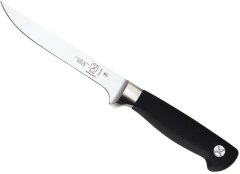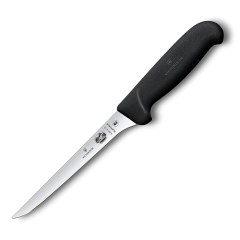BestReviews is reader-supported and may earn an affiliate commission. Details

These quality knives are made in Germany with high-carbon steel that will keep an edge and last for years.
Forged from a solid piece of steel for durability. Ice-hardened blade keeps sharper than most competitors. Ergonomic handle keeps your grip sturdy. Great knife for heavy-duty butchery.
Sharpness might not be ideal for newcomers.

This boning knife is perfect for your Thanksgiving turkey thanks to its easy-to-use design and sharp blade.
Impressively sturdy for a simple knife. Built to guide along bone without wasting meat or slippage. Blade is hand-honed for best possible edge. Great starter knife for new home butchers.
While good for beginners, veterans might want more.

Mercer steel is some of the most respected on the market, and this boning knife shows you why.
Santoprene handle will keep a grip without harming your hand. High-carbon German steel resists standard rust and discoloration. Edge is built to glide along bone. Great for holiday roasts and large meat quantities.
Might be difficult to sharpen at home.

These German stainless steel boning knives come from one of the marquee brands in cutlery.
Henckels steel is noted for its toughness and sharp blades. Forged construction makes blade feel like part of handle. Triple-rivet design is curved for increased comfort. Dishwasher safe.
Some find knife too thick for precise uses.

This Swiss knife is a one-stop-shop for most cutting needs.
Lightweight European steel cuts through meat and vegetables with ease. Versatile knife for standard kitchen feats. Flexible when precision is needed, but sturdy enough for cutting.
Some find it too blunt out of the box.

We recommend these products based on an intensive research process that's designed to cut through the noise and find the top products in this space. Guided by experts, we spend hours looking into the factors that matter, to bring you these selections.

A boning knife isn’t typically the first utensil people think to buy when outfitting a kitchen. If there’s one in the knife set, they might not even know what to do with it. Can’t a chef’s knife cut steaks, dress chicken, and skin fish? Yes, but it doesn’t do everything as well as a boning knife.
A boning knife is specifically designed to remove meat from bones, fat, skin, and connective tissue. It has a thinner blade than a chef’s knife, with a distinctive curve and long, sharp tip. The blade has a bit of flexibility, so it’s easier to maneuver. Boning knives usually have a blade about 9 inches long.
Cutting your own meat has a number of benefits, including saving money. Bigger cuts of meat cost less per pound. You also have more control over the meat and its shape, thickness, and fat content. For these reasons and more, you’ll want a boning knife. It might not make you an expert butcher, but it does what it’s designed to do better, faster, and more precisely than any other kind of knife. A good buying guide can help you find the right boning knife for your kitchen.

Kitchen knives are available in two styles: Western and Japanese, and this holds true with boning knives.
Western or European boning knife: This style has a narrow, slender blade with a curve or arch and usually a pronounced bolster where the blade meets the handle. These boning knives are more flexible than the Japanese variety.
Japanese boning knife: The honesuki has a straighter triangular-shaped blade without the arch or bolster. Japanese knives are harder and sharper than Western knives.
Kitchen knives in general, including boning knives, should be made of either stainless steel or carbon steel.
Carbon steel is softer and more flexible than stainless steel, but it can tarnish. The blades stay sharp longer than stainless steel blades.
Damascus steel is a high-carbon steel with a distinctive wave and ripple pattern in the blade. It’s used for both Japanese- and Western-style knives.
Stainless steel is strong and resists tarnishing, but it’s harder to sharpen than carbon steel.
Boning knives tend to be shorter than chef’s or carving knives, with blades about 5 to 9 inches long. Blade length affects control and efficiency: a shorter blade helps you be more precise, while longer blade saws and slices more quickly and smoothly.
Despite its smaller size, a boning knife should have a bit of heft to it to help with the precise movements required to bone and skin meat. The weightier handle makes the blade more nimble.
A boning knife’s handle should fit comfortably in the hand and enable you to feel in control of the knife when using it. Handles can be made of wood, metal, resin, or other materials and may be smooth, textured, or molded to fit the hand. Make sure the handle is easy to clean and won’t accumulate stains or food particles.
Look for a knife handle with a full tang, which extends the whole length of the handle and is riveted in place. This type of handle is stronger and safer.

The blade tends to be more flexible than that of a chef’s knife or utility knife. This flexibility allows you to follow the curve of bones and joints and assists in removing fat, skin, and connective tissue. The amount of flexibility differs from model to model and brand to brand. Some boning knives aren’t very flexible at all. A blade that’s too flexible is impractical for doing the heavy work that requires long, clean strokes and breaking through cartilage and small bones.
Arch: Most Western-style boning knives have an arched blade with a definite curve near the base of the cutting edge. This arch allows you to maximize the length of the cutting edge when carving and slicing. Traditional Japanese-style boning knives lack this arch, but some Japanese cutlery brands offer boning knives with arched blades.
Curve: Some boning knife blades also curve up from handle to tip. This also maximizes the blade’s cutting edge and slicing power. Not all Western-style boning knives have a curved blade, although many Japanese-style boning knives do.
Tip: The tip or point of a boning knife is longer, more slender, and more precise than that of a chef’s knife. This is well suited to doing delicate work, allowing the user to make smaller cuts or holes.
The bolster is the thick metal section between the handle and the blade. In many Western-style boning knives, the bolster extends past the arched section of the blade and functions as a finger guard. Not all boning knives have an extended bolster, and most Japanese-style knives don’t.
The handle on some boning knives is contoured or textured to facilitate grip. Some handles are rubberized or have some other soft, grippy surface, such as silicone. These handles can be harder to clean than those with a smooth, nonporous surface.
Use the long, thin tip of a boning knife to make a small incision in the meat. It allows you to cut and slice cleanly.
Boning knives need sharpening more often than other knives due to their frequent contact with tough sinew and bone. If you want to sharpen your knives yourself, consider purchasing a sharpening machine or sharpening stone.
A knife block protects and displays your kitchen knife collection. Many knife sets come with a block, but you can buy one separately. Look for one with a slot that will accommodate the narrow blade of a boning knife.
It’s a good idea to invest in more than one cutting board, especially if you plan on butchering and preparing your own meat, fish, and poultry, so you can use a second one for vegetables and fruit. A good-quality wood cutting board helps keep knife edges sharp and slick foods secure.
You can find boning knives that cost $25 and less, including a few well-known brands like Victorinox, Dexter Russell, and Mercer Culinary. These knives will do the job, but they may lack some of the refinements found in higher-end cutlery, such as higher-quality steel or handle materials.
Solid, long-lasting boning knives from good brands cost between $25 and $100, including Japanese-style knives from brands like Dalstrong or Kyoku, and Western-style knives from JA Henckels and others, with good-quality steel and solid warranties or guarantees.
High-priced boning knives cost over $120, and sometimes well over. In this price range are the top picks for Western-style boning knives from brands like Wüsthof and Zwilling manufactured in Europe, or premium Japanese-style boning knives made by craftspeople in Japan. Expect premium materials and craftsmanship with super-sharp edges and performance from knives in this price range.


A. The two knives closely resemble each other because they have similar uses. Filleting knives are a bit more specialized because they’re primarily designed for skinning and deboning fish. The blade is more flexible and often more curved than that of a boning knife to cleanly separate the delicate flesh from skin and bone. In a pinch, a boning knife can be used on fish and a filleting knife works for meats or fruit.
A. A cleaver is also used for butchering and dressing meat, but it’s almost the opposite of a boning knife. It has a broad, thick blade that’s strong enough to chop through tough joints and thicker bone, with no tip or point at all.
A. No. These knives can’t cut through bone, unless the bones are small and thin like chicken ribs. In this case, the term “boning” refers to separating the meat from the bone.
Get emails you’ll love.
Learn about the products you’re wondering if you should buy and get advice on using your latest purchases.
